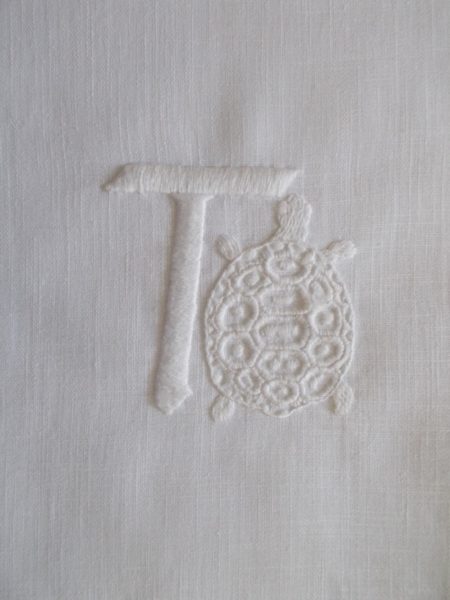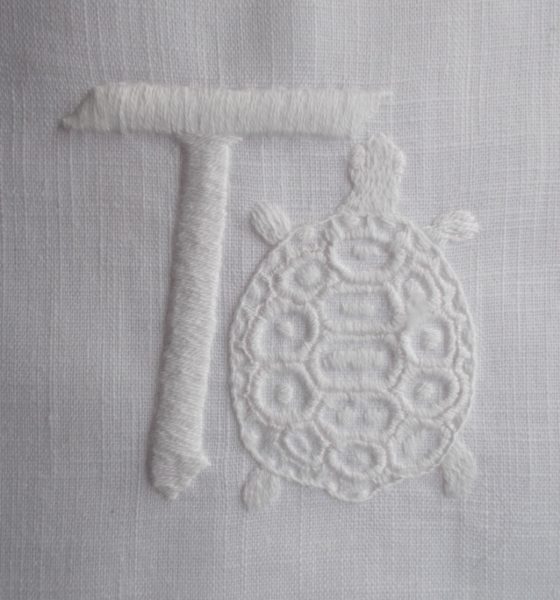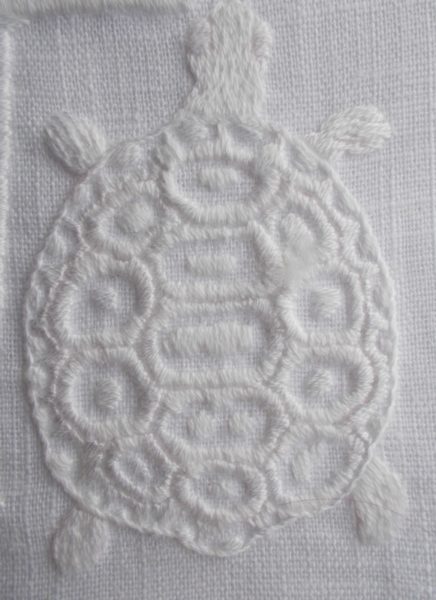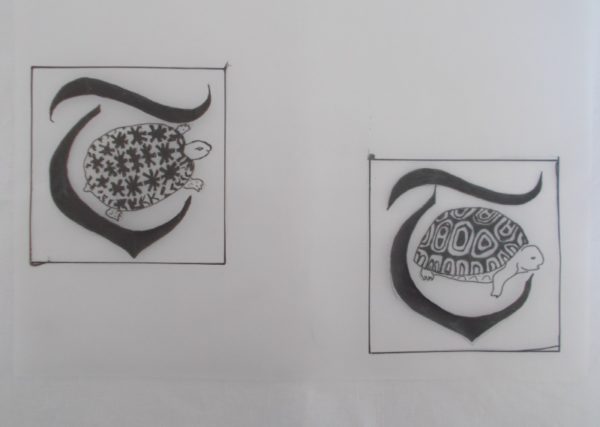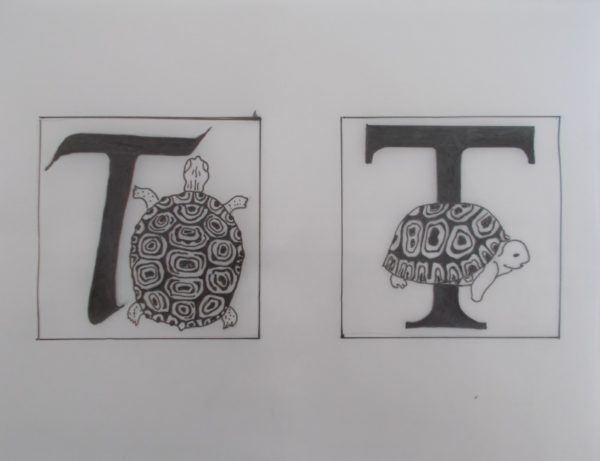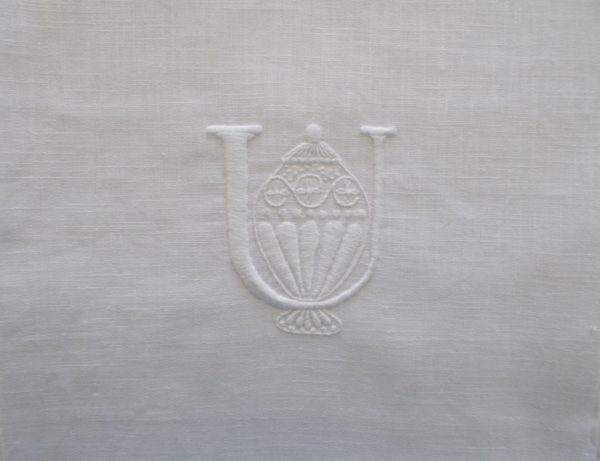
U is for urn (hand embroidered by Mary Addison)
For this week’s letter I’ve turned my back on animals or flowers and found myself drawn to U for Urn which elegant classical form fits so satisfyingly within the swoop of the letter as to suggest they were made for each other. It then occurred to me that two memories come unbidden to mind whenever I think of the word urn, just like the word soporific instantly summons up a picture of Peter Rabbit (and lettuces) or the way my mental image of an MRI scanner is haloed about by ghostly letters spelling out a wobbly claustrophobia. It’s the joy of writing a blog that these things come to mind at all and, to go one step further back, the embroidering of a different letter each week has been a wonderful catalyst to bringing to the surface things that swim around in your head but very rarely get presented for further consideration.
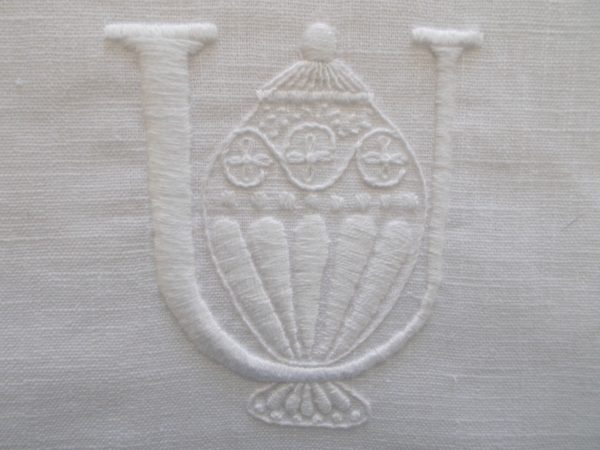
U is for urn (hand embroidered by Mary Addison)
The first time urn came to arouse my curiosity was when I was working on the desk in Monmouth Public Library. I always enjoyed it when someone asked for something on the county’s catalogue, though not in our library – usually it was to work through a popular author’s entire oeuvre or to ask for some classic no longer deemed popular enough to be on open shelves (rather too many glorious titles), but one day during, I think, one of our evening openings an elderly man, grizzled haired but spry came in to ask for “Urn Burial” by Sir Thomas Browne. Never heard of it ?- no, me neither ! How morbid, I thought. Well, in between the book coming in and being collected I had a little look – it is only 50 or so pages, followed up with a bit of an internet search and was surprised to find how influential this small book has been and what joy its contemplation has aroused.
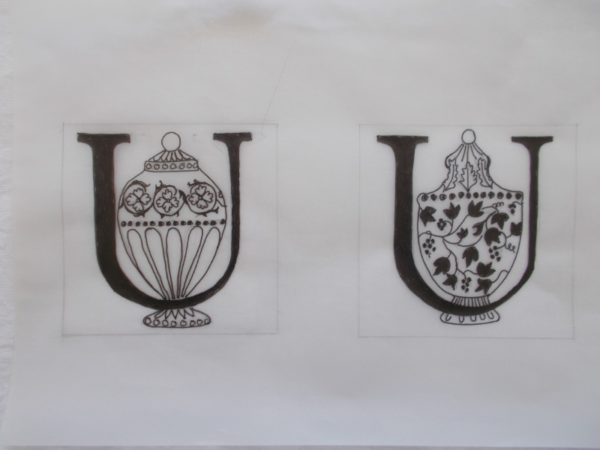
Sketches of U for Urn
Published in 1658, its full title is “Hydriotaphia, Urn Burial or A Discourse of the Sepulchral Urns lately found in Norfolk”. The English Civil War (1642-1651) was not long over and out of a population of nearly 5 million, about 200,000 had lost their lives. The unearthing of some 50 Roman burial urns in almost perfect condition, along with reflections on those who had died during the war seems to have triggered Browne to write about that most unspoken state of the human condition – death and after – which ruminations he flavoured with a delicious but not overindulgent melancholy. Robert McCrum wonders, “Is melancholy, following Freud, merely an unproductive form of mourning ? Or can it be an uplifting form of sadness that infuses consciousness with new possibilities?” Oh let’s hope it ‘s the latter, we have a need to feel something positive will come out of our current crisis. Browne’s own melancholy over concerns of this world was held in check to some degree by the comfort he found in his Christian Faith, something many fewer feel they have to support them today. But, let’s leave Urn Burial with his cheering words on being human. “Life is a pure flame; and we live by an invisible sun within us.”
Also, Browne was a great coiner of new words, about 800 are credited to him in the Oxford English Dictionary, the most surprising of which are probably computer and holocaust.
Urn Burial is No 93 on The Guardian’s 100 Best Non Fiction Books – do read Robert McCrum giving his support to the book here.
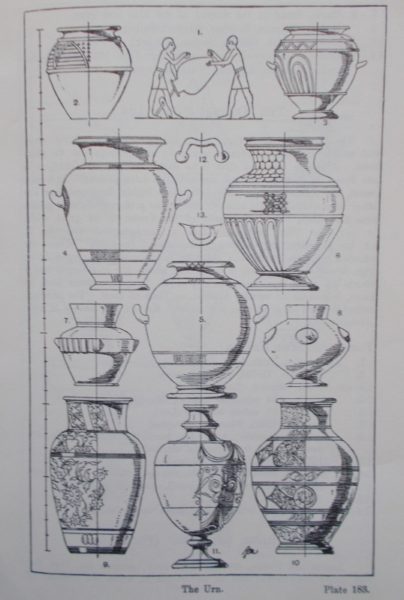
A page of urns from Dover’s Handbook of Ornaments by Franz Sales Meyer
The other urn story that comes to mind concerns a painting which I think I had described to me so vividly that I’ve convinced myself I’ve seen it but I’m not at all sure I can have done.
Years ago our family made friends with an American and his family when the father was doing a PhD in London. They, like me and my first husband, had a daughter called Allegra which excited my first husband to catch up with them one day after school and playfully remonstrate that we hadn’t called our daughter Allegra in order to bump into another one. (I know there’s more around now). Of course, we have been firm friends ever since. Well, Patrick is a real polymath – linguist, including Latin and Greek, archaeologist, musician, etc. etc. and he has the sort of chutzpah we British can only gawp at in admiration without ever being able to emulate. One day he was sauntering down Bond Street, as you do, and came upon a painting in the window of The Fine Art Society. He stood in contemplation for a few minutes and then went into the gallery to ask whether they understood the iconography of the painting, which he proceeded to explain to them. Patrick reports polite, even enthusiastic listening and this he followed with a more full and finished version on paper which he then sent to them – as well as giving a copy to us, which I have somewhere but can’t yet find. The cynic in me wonders whether the gallery staff weren’t a bit miffed by this unexpected art appreciation lesson though the charm of the man may well have carried the day for him. Ah, yes the painting. It was a largish work showing Persephone (in gold – crocus yellow?) standing beside a red and black figured funerary urn and either holding poppies or surrounded by them. (Though I’m sure Patrick referred to them as Papaver somniferum which are a mauvey white to mauve not the red ones I ‘remember’ being in the painting.) I thought the painter was Theodore Roussel but internet searches reveal nothing even vaguely similar – though there is no reason why it should if the picture’s in private hands. Did I make it up – no it’s far too vivid for my imagination? Did I go along to Bond Street to ogle at the said painting? I just can’t remember. Now I’ve written about it I realise I must sort this out, so I shall contact Patrick, who will undoubtedly pluck all the details out of his filing cabinet mind and I’ll report back here. Now I wish I’d scattered a few poppies around my own little embroidered urn – pity I’ve just washed and ironed it.

